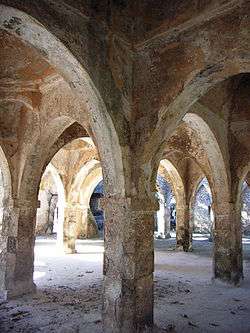Great Mosque of Kilwa
| Great Mosque of Kilwa | |
|---|---|
 | |
| Basic information | |
| Geographic coordinates | 8°58′00″S 39°32′00″E / 8.96666666666667°S 39.5333333333333°E |
| Affiliation | Islam |
| Architectural style | Traditional Islamic architecture |
The Great Mosque of Kilwa is a congregational mosque on the island of Kilwa Kisiwani, in Tanzania. It was likely founded in the tenth century, but the two major stages of construction date to the eleventh or twelfth and thirteenth century, respectively. It is one of the earliest surviving mosques on the east African coast and is one of the first mosques built without a courtyard.
The smaller northern prayer hall dates to the first phase of construction and was built in the 11th or 12th century. It contained a total of 16 bays, supported by nine pillars, originally carved from coral but later replaced by timber. The structure, which was entirely roofed, was perhaps one of the first mosques to have been originally built without a courtyard.
It was modified in the 13th century adding side pilasters, timber, transverse beams.
In the early fourteenth century, Sultan al-Hasan ibn Sulaiman, who also built the nearby Palace of Husuni Kubwa, added a southern extension which included a great dome. This dome was described by Ibn Battuta after he visited Kilwa in 1331.
External links